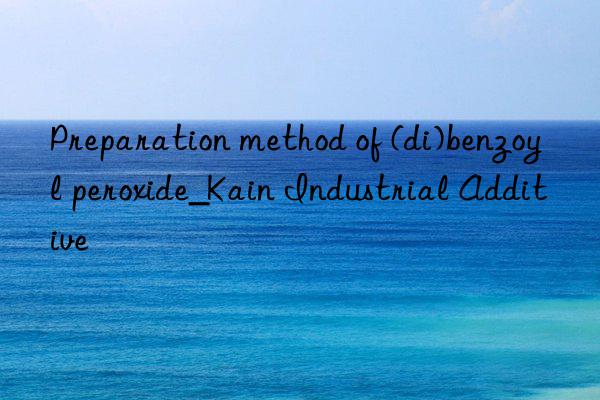
Background and overview[1]
(Di)Benzoyl peroxide is also known as benzoyl peroxide, and its common name is initiator BPO. Benzoyl peroxide is a white crystal powder at room temperature, with a slight smell of bitter almonds. It is soluble in benzene, chloroform, ether, slightly soluble in ethanol and water; it can be used as polyvinyl chloride, unsaturated polyester, Monomer polymerization initiators such as polyacrylate can also be used as cross-linking agents for polyethylene and rubber vulcanizing agents. At present, the main method for producing benzoyl peroxide in my country is to add hydrogen peroxide to sodium hydroxide solution under cooling conditions to generate an aqueous sodium peroxide solution; then add benzoyl chloride dropwise under stirring conditions to generate The (di)benzoyl peroxide is precipitated, and after cooling, filtering and washing, the (di)benzoyl peroxide product is obtained. However, during the preparation process, a large amount of synthetic mother liquor and washing water are produced. This water contains water-soluble peroxide (sodium peroxybenzoate), sodium hydroxide, sodium chloride and sodium benzoate, causing serious environmental pollution. .
Preparation[1]
Method 1: A method for preparing (di)benzoyl peroxide, including the following steps:
(1) Mix 383.4kg of 18.06% recycled sodium chloride solution, 63.8kg of 10% sodium hydroxide solution, 20.5kg of 70% hydrogen peroxide aqueous solution, 0.61kg of twelve Add sodium alkylbenzene sulfonate into the reaction kettle, control the reaction temperature to 15°C, stir and mix evenly to obtain a reaction liquid;
(2) Add 19.2kg benzoyl chloride dropwise into the reaction solution, keeping the temperature constant, and keep the temperature for 30 minutes after the dropwise addition is completed to obtain crude (di)benzoyl peroxide;
(3) Input the crude (di)benzoyl peroxide into the rinsing tank, turn on the stirring device of the rinsing tank, and after continuous washing with water, transport it to the centrifuge by the conveying device at a rotation speed of 1000 rpm. Centrifuge for 15 minutes to achieve solid-liquid separation, and obtain liquid materials and physical materials. The obtained liquid materials are benzoyl peroxide wastewater; the solid materials obtained are benzoyl peroxide, and the benzene peroxide obtained is The yield of formyl (based on benzoyl chloride) was 98.8%, and the purity was 99.21%.
(4) Use a filter bag with a pore size of 50 μm to filter the benzoyl peroxide wastewater, put a total of 1000kg of the filtered benzoyl peroxide wastewater into a storage tank, and then put all the benzoyl peroxide wastewater into a storage tank. The (di)benzoyl peroxide wastewater was heated to 70°C and kept for 1 hour to carry out decomposition reaction. A hydrochloric acid solution with a mass fraction of 32% was added to the obtained decomposition liquid to adjust the pH value to 1.5, and acid precipitation was carried out at 5°C. Centrifuge the obtained material for 10 minutes at a rotation speed of 1000 rpm for solid-liquid separation, wash the obtained solid material to neutrality, and then dry it to obtain benzoic acid; adjust the pH of the obtained liquid material with a mass fraction of 31% sodium hydroxide solution value to 7, and 969kg of recovered sodium chloride solution with a mass fraction of 18.06% was obtained, and the obtained recovered sodium chloride solution was used in step (1).
Main reference materials
[1]CN201910132211.3 A preparation method of (di)benzoyl peroxide

 微信扫一扫打赏
微信扫一扫打赏

